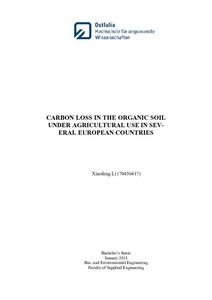Carbon loss in the organic soil under agricultural use in several European countries
Li, Xiaofeng (2018)
Li, Xiaofeng
2018
All rights reserved. This publication is copyrighted. You may download, display and print it for Your own personal use. Commercial use is prohibited.
Julkaisun pysyvä osoite on
https://urn.fi/URN:NBN:fi:amk-201904245806
https://urn.fi/URN:NBN:fi:amk-201904245806
Tiivistelmä
Global warming occurred in the past without manmade activities, the Earth was warme6d 5 degrees Celsius during the period of 5,000 years from the Little Ice Age. Over the past century, the global temperature rose approximately 1,1 degrees Celsius, which is roughly ten times faster than the ice-age-recovery warming rate. The unusually rapid warming is caused by the extremely increasing amount of greenhouse gases in the atmosphere, which are carbon dioxide, methane, nitrous oxide and fluorinated gases. Energy, industrial processes and product use, agriculture, land use, land-use change and forestry, waste and other are recognised as the greenhouse gases sources according to statistics from the European Commission. The sector of land use, land-use change, and forestry contributes approximately 10 percent to the total greenhouse gas emissions in the European Union member countries. Globally, it accounts for 15 to 20 percent of the total emissions. Vegetation and soil make up the largest terrestrial carbon pool and global carbon pool in terms of carbon exchange with the atmosphere. Therefore, determining the carbon loss from organic soils becomes significant research for global warming.
Carbon in the organic matter is converted to carbon dioxide by microbial decomposition under aerobic conditions, while anaerobic conditions enhance the production of methane. Agricultural cultivation and drainage of lands introduce oxygen into soil pores, which accelerate the production of carbon dioxide, thus increasing the rate of carbon emissions to the atmosphere.
Sites with a variety of land cover types are studied in Denmark, Estonia, Germany, and the Netherlands. Parameters of bulk density and loss of ignition are measured for the calculation of carbon losses. A statistical analysis of agricultural cultivation time, land cover types, decomposition and its influencing factors on carbon loss was conducted. The obtained data shows that a longer cultivation history exhibits higher levels of carbon loss for a certain land cover type. In addition, soils that are high in carbon stock show high levels of carbon loss. The value of carbon loss through the intensively managed grassland is the highest, while carbon loss through the arable land is the second highest. Appropriate soil conditions beneficial for microbial decomposition promote an increasing level of carbon loss.
Carbon in the organic matter is converted to carbon dioxide by microbial decomposition under aerobic conditions, while anaerobic conditions enhance the production of methane. Agricultural cultivation and drainage of lands introduce oxygen into soil pores, which accelerate the production of carbon dioxide, thus increasing the rate of carbon emissions to the atmosphere.
Sites with a variety of land cover types are studied in Denmark, Estonia, Germany, and the Netherlands. Parameters of bulk density and loss of ignition are measured for the calculation of carbon losses. A statistical analysis of agricultural cultivation time, land cover types, decomposition and its influencing factors on carbon loss was conducted. The obtained data shows that a longer cultivation history exhibits higher levels of carbon loss for a certain land cover type. In addition, soils that are high in carbon stock show high levels of carbon loss. The value of carbon loss through the intensively managed grassland is the highest, while carbon loss through the arable land is the second highest. Appropriate soil conditions beneficial for microbial decomposition promote an increasing level of carbon loss.
